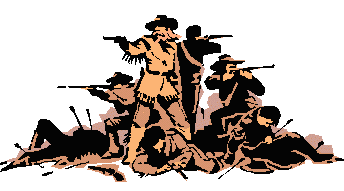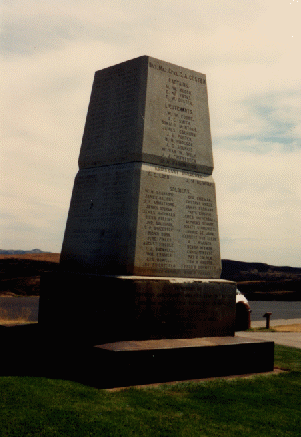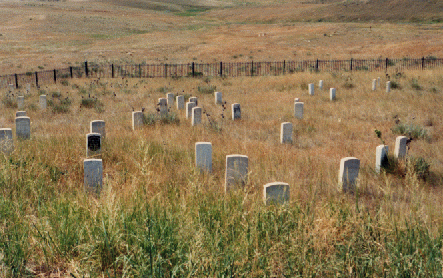

Few events have captured the interest and the imagination of the American people over such a long period of time as the battle that took place at the Little Big Horn River in Montana. For this is where George Armstrong Custer and 225 of his men died in what has become known as Custer’s Last Stand.
The Battle of the Little Big Horn took place on June 25, l876 and from the time the news reached a shocked nation till today it has become a part of our history and legend that never wanes or loses its appeal. The names of those who fought there on both sides still intrigue and fascinate us l21 years later.
Today everyone can experience some of the history and drama , as well as a true understanding of the events that day, by visiting the Little Bighorn Battlefield Monument located on the Crow Indian Reservation on Interstate 90 just two hours east of Billings, Montana. Operated by the National Park Service as a National Monument, the Battlefield and Museum are open daily.
Tours are available with interpretive guides or you can follow the route and events of the battle in your own car. A cassette tape is available at the Visitor Center which outlines the events as they took place on that eventful hot June day.
George Custer, in command of the 7th Cavalry and a hero of the Civil War, came toward the Little Big Horn from the North as part of a three column offensive by the U. S. Army . Custer knew that there were hostile Indians in the area but had no knowledge of their actual strength.
The 7th Cavalry numbered 600 men and acting on information supplied by his Scouts, Custer planned to attack. During that day Custer divided his command again and again underestimating both the number and fighting ability of the Sioux and Cheyenne warriors hidden from view by the rolling terrain.

A road now follows the ridge and route of the Battle and markers illustrate the course of Custer’s companies as well as where soldiers fought and died. The road ends where Major Reno and his troopers first met the Indians at the River and their retreat to the bluffs above. And it is here that Captain Benteen, the true hero of the battle, and his men made a stand and lived to see another day.
The tape will explain as you travel the ridge road the events as they took place; Weir Point, where Custers' Companies were last seen; Calhoun Ridge, where one Company was pursued and destroyed; and finally Custer Hill where 225 men fought till the end.
A monument with the names of those who died that day marks where the Stand was made and individual markers show where each soldier fell.
The Battlefield is rolling grasslands broken by deep carved coulees and looks today much as it did then. Plan on at least half a day to visit the Battlefield, although a full day is better.
First stop at the Visitor Center where photos and artifacts of the Battle are on exhibit. Then take the seven mile road that retraces one of the most famous days in American history. There is ample parking at the Visitor Center and at the monument at the top of Custer Hill. At the Benteen battleground an asphalt path takes you through the places where American soldiers showed gallantry and courage.
It also shows the mettle and skill of the native Americans who fought there that day.
There is no overnight camping at the Monument. But Hardin, Montana is only l8 miles northwest with all services including motels and RV Parks. And the Crow Nation has two Casino hotels just outside the Monument.

Our visit to the Battlefields was made on a hot summer day much like that June day in l876. Looking at the shallow holes dug by Benteen’s men seeking protection from Indian fire coming from higher ground; retracing the route of the hero volunteers who went down the Ravine to get water from the River; the lonely marker of First Sgt. Hardin who tried to get reinforcements to Custer; they are all as they were.
The names of those who fought there are still as famous today as ever—Custer, Reno, Benteen, Weir, and Calhoun as well as Sitting Bull, Two Moon, Gall and Lame White Man. The agony of the defeat marked Americans for a generation and the Battle took on a life of its own with illustrations and paintings.
Hanging in thousands of bars and taverns was the painting of Custer’s last stand thanks to its commission and large scale distribution by Anheuser Busch Brewing Company.
Many of us can remember Hollywood’s version with Errol Flynn as Custer, clad in buckskins, fighting till the last in “They Died With Their Boots On”. More recently a mini-series appeared on television entitled “Son of Morning Star” depicting the Man and the Battle.
The entrance fee by the National Park Service is $ 4 per vehicle at the Monument. The Cassette Tape describing the events about $5. For this you can relive one of this country’s most memorable events and understand how and why it occurred. On this visit you are a part of history.
